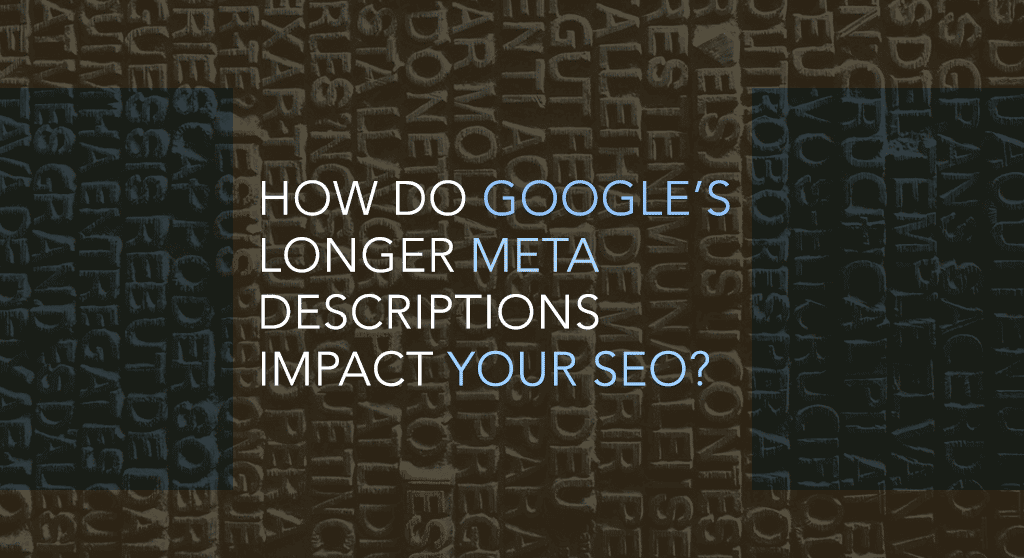
Editor’s Note: After a few months of testing longer meta descriptions, Google changed the length back to a shorter format. If you’re confused about the switcheroo, read our SEO update on the new Google meta description length
Google now displays longer meta descriptions for search results. Here’s the 411.
You know how we’re always saying that SEO is a fast-developing field and you need be rigorous in your ongoing professional development lest you fall behind, fail to take advantage of emerging opportunities, and may even deliver bad or outdated information?
Well, here’s a case in point. Google’s meta description length, long restricted to 160 characters, has now doubled to approximately 320.
This may not sound like the most dramatic change ever, but for SEOs—and anyone wanting to boost their click-through-rate (CTR)—it’s a change worth paying attention to. Meta descriptions, the short lines of text that appear below search results on Google, provide a prime opportunity for marketers to convince visitors to click through to our content.
Why would Google offer longer meta descriptions?
Why does Google do anything? To improve search results. Let’s say you’re searching for something you know nothing about. Up pops a long list of search results. With only one-hundred and sixty characters, most searchers with minimal knowledge about their search query have very little context to understand which result will be the most relevant to them. They may have to click through several links to find one that gives them what they want.
With a longer description, searches have more context to understand which pages are most likely to be useful to them. This may mean that they can find their answer without having to click anywhere, but it should also mean that they will be less likely to bounce when they do click through.
Does this mean fewer people will click through to my content?
I wouldn’t think so. Yes, searchers who are only interested in a 300-character answer may not click through. But those aren’t likely to be high-quality leads, either. Google may make it easier for searchers looking for only the briefest answer to find what they need and move along, but for the rest of us, the extended meta description is an opportunity—not a threat.
Meta descriptions have never been a direct ranking factor. Google doesn’t put you higher in the search results because of them. They are an opportunity to draw in readers—to advertise your content, as it were. Longer meta descriptions give you more space to do that. But they also take up more real estate on search engine result pages (SERPs).
That said, if you aren’t landing in the top SERP spots, your page appear farther down Google’s search results. Searchers will have farther to scroll before they find your page, and you’ll have to be more competitive to earn the top spots. This has already been the case with the advent of featured snippets, some of which are large enough to push even the top-ranked post farther down. So, longer meta descriptions may result in even lower CTRs for posts that rank below the top two or three.
However, if you do manage to rank higher, the additional room not only pushes your competitors farther out of sight, it also raises your brand profile. Searchers who see your name attached to a URL or featured snippet may remember you in future, even if they don’t click through right away.
What about featured snippets?
As we covered recently, featured snippets often have a positive impact on CTR. If you can write a post that is informative, well-organized, and focused on a specific answer, there’s a reasonable chance your blog will get featured as one of Google’s featured snippets. Like meta descriptions, featured snippets provide short answers to searchers. Being selected for a featured snippet can help raise your credibility with searchers, but there’s no way to guarantee your post will become a snippet. Focus on these to the extent that you see a marketing opportunity, but don’t let them distract you from other marketing opportunities.
Should you go back and re-write old meta descriptions to make them longer?
This probably isn’t necessary. If your older, shorter meta descriptions still seem to be performing well, it’s likely you can leave them in place with no ill effect. However, if you have some high-ranking content that’s performed well in the past, then it may be worthwhile to return to those pieces and write longer meta descriptions for them.
So, how should you handle longer meta descriptions for SEO?
The bottom line is this: You can now write longer meta descriptions. That gives you more space to sell your posts, but it will also make ranking for the top spots more difficult. As you write new content, make use of your increased space to write thoughtful, user-oriented content.
We expect doing so will have a positive, long-term impact on your SEO, but this change is too new for us to have a complete idea about its impact. We’ll keep an eye out for new developments and let you know about them as we learn more.
